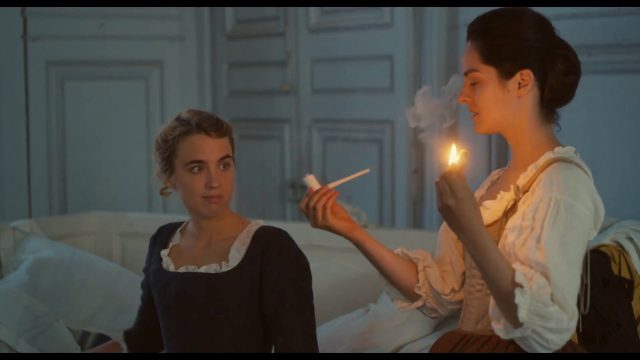It was on my second viewing of Celine Sciamma’s Portrait of a Lady on Fire that I realized the film is a ghost story. Historic queer narratives are often tragic and fleeting; it isn’t unusual to watch such a romance and know from the start that the protagonists won’t be able to continue their relationship long term, at least not in any conventional sense. But there is a uniquely ethereal quality to Portrait, making the connection between Marianne (Noémie Merlant) and Héloïse, (Adèle Haenel) feel like memory even as it is playing out in the present moment.
Portrait opens with Marianne arriving on a remote French island. The isolation is immediately noticeable. There are no neighbors in sight, and only three people inhabit the large home Marianne is visiting — Héloïse,, her mother (Valeria Golino), and their servant, Sophie (Luana Bajrami). Little is spoken of Héloïse,’s deceased sister, and even less about her father. In lieu of a proper guest room, Marianne is brought to an unused parlor, in which she will stay and work for the duration of her visit. It is the sort of home where one expects entire rooms to be off limits to both guests and residents, for fear of disturbing the spirits therein.
Marianne’s visit to the island has a purpose. She is an artist who has been commissioned to paint Héloïse’s portrait, which will be sent to her arranged, anonymous fiancé in Milan. Objecting to the marriage, Heloise refuses to sit for portraits. Her mother’s request to Marianne is that she accompany Heloise on walks, so that she may study her features and paint her in secret.
Before Marianne sees Héloïse’s face, she sees the absence of it. After settling into her room, Marianne finds the attempted portrait painted by the artist who visited before her. Héloïse never allowed him to see her face; when Marianne turns the canvas around, she sees Heloise’s body with thick splotches of paint covering the area where her face should be. The appearance of the painting feels cursed, haunted. Caution all who attempt to paint this woman, for their souls will be ripped from their bodies and their artwork demolished.
When Marianne finally meets Héloïse, her face remains elusive at first. Marianne walks behind Héloïse who is wearing a hooded cloak that obscures much of her body. As she begins to walk faster and faster, eventually running toward the edge of a cliff, her cloak slips more and more, revealing her hair and clothing. Finally, once she reaches the edge, she turns around so that Marianne can see her face. It’s a clear moment of connection, the beginning and end of their union.
Though Marianne and Héloïse’s relationship gradually develops from friendly to romantic, they are constantly aware of its inevitable expiration. There are moments when they are fully present with each other, but often they end up speaking about what will happen when Héloïse leaves for Milan, to enter the marriage she is powerless to prevent. And even when they don’t speak of that reality, it lingers in the air ominously, never leaving them entirely.
It is no wonder that Héloïse is preoccupied with death. She indulges Marianne’s curiosity about her sister, risks her own safety by running into water without knowing if she can swim, reads about the death of Eurydice, and expresses a fascination with the termination of Sophie’s pregnancy. All of these actions are how she copes with the end of her life (and freedom) as she knows it. And they are all the more reason for Marianne’s documentation. She must paint and draw Héloïse at her most lively, not because their time together is limited, but because that version of Héloïse will soon cease to exist entirely.
Eventually, Marianne starts encountering ghostly visions as she moves through the house. She sees a spectre of Héloïse in a white dress, haunting the empty hallways of an already too-empty house. Her final moments with Héloïse are when Héloïse has become that ghost, wearing her wedding dress. She is already a memory, already gone.
An epilogue reveals that Marianne saw Héloïse two more times, but they were unable to communicate, and Héloïse never knew she was there. Those final sightings are apparitions, images that evoke the memory of what was, and what could have been, without the ability to bring it back to life. Portrait is framed by Héloïse’s absence and ghostly presence. What happens in between is real, and it is passionate, but it is always already a memorial to what no longer exists.

